In today’s fast-paced world, the tablet PC is a top choice for many. It’s a device that combines the best of smartphones and laptops. But with so many options out there, how do you know you’re making the right choice? We’ll help you with that. We’ll cover the key things to think about when buying a tablet PC. This way, you can find the perfect one for your needs and budget.
Key Takeaways
- Tablets have evolved from consumption-only devices to productivity and entertainment tools, with options for all age groups.
- Factors like display quality, operating system, and connectivity options are crucial when selecting the right tablet PC.
- Battery life and storage capacity are important considerations for ensuring your tablet meets your usage requirements.
- Prices for tablets range widely, from budget-friendly options to high-end models with advanced features.
- Choosing between Wi-Fi-only or cellular-enabled tablets depends on your internet usage needs and data plan preferences.
Determining Your Budget for a Tablet PC
Price Range and Features
Buying a tablet PC can range from $60 to over $1,000. At the low end, you get tablets like the Amazon Fire and Walmart’s Onn brand. These are great for web browsing, social media, and watching videos, costing less than $100.
Mid-range tablets from Lenovo and Samsung are priced between $300 and $500. They offer better performance and more features. They’re perfect for those who want a good balance of cost and capabilities.
At the high end, you’ll find tablets like the iPad Pro and Microsoft Surface Pro, priced over $800. These tablets have amazing displays, processing power, and can do a lot. They’re great for those who need top performance and versatility.
When picking a budget for a tablet PC, think about what you need and how you’ll use it. Whether you’re just starting out, work on the go, or are somewhere in between, there’s a tablet for you and your budget.
| Price Range | Tablet Models | Key Features |
|---|---|---|
| $100-$300 |
|
|
| $300-$500 |
|
|
| $800-$1,000+ |
|
|
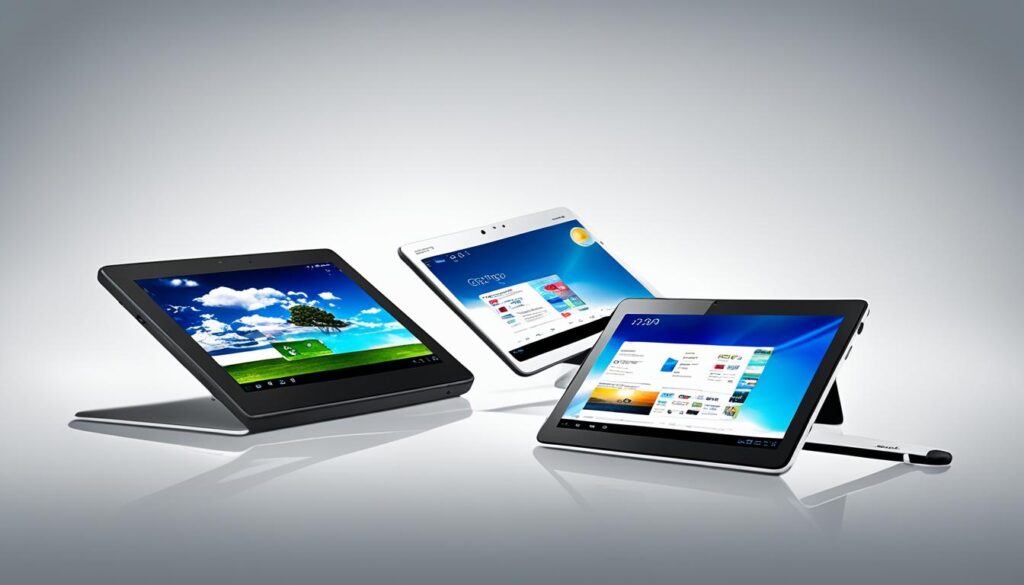
Think about your budget and what you need from a tablet. This way, you can find the perfect tablet, whether you want something affordable or a device packed with features.
Display Quality: Size, Resolution, and Viewing Experience
Choosing the right tablet means looking at the display quality closely. You can find tablets with screens from 7 inches to 12.9 inches. Each size offers a different way to enjoy media and work.
Larger screens give you a more immersive experience, perfect for watching movies or working on big projects. Smaller screens are great for being on the go and easy to carry around.
The resolution of the screen is also key to the quality. Higher resolutions like 1080p or 2K make images sharp and clear. This is great for photo editing, watching videos, and reading documents.
Other things like viewing angles, brightness, and screen coatings matter too. Wide viewing angles and high brightness make it easy to see the screen in any light. Anti-glare coatings help reduce eye strain when you’re using the tablet a lot.
| Tablet Model | Display Size | Display Resolution | Display Quality |
|---|---|---|---|
| Apple iPad Pro | 11-inch / 12.9-inch | 2048 x 2732 pixels | Liquid Retina XDR display with ProMotion, up to 1600 nits peak brightness |
| Samsung Galaxy Tab S9 Ultra | 14.6-inch | 2960 x 1848 pixels | Dynamic AMOLED 2X display with 120Hz refresh rate, HDR10+, and peak brightness of 1750 nits |
| Microsoft Surface Go 3 | 10.5-inch | 1920 x 1280 pixels | PixelSense display with 3:2 aspect ratio, Corning Gorilla Glass 3, and up to 450 nits brightness |
When picking a tablet, think about the size, resolution, and quality of the display. Make sure it fits your needs and gives you a great viewing experience.
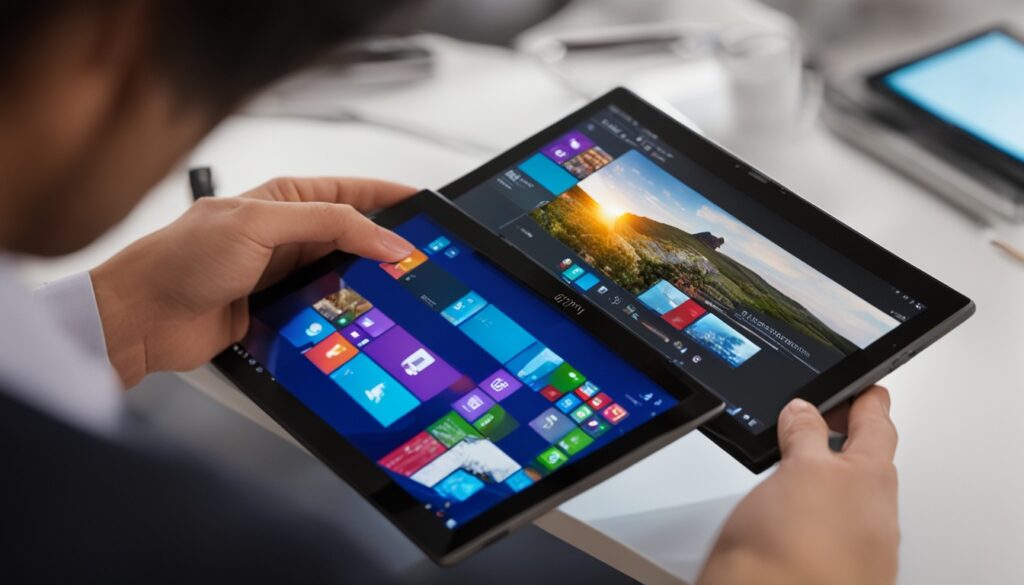
Operating System: iOS, Android, or Windows
Choosing a tablet means picking the right operating system (OS). There are three main ones: iOS, Android, and Windows. Each has its own strengths and uses. Knowing the differences helps us pick the best tablet for our needs, whether for watching media, working, or both.
The iOS operating system is on Apple’s iPad. It’s known for its easy use, lots of apps, and working well with other Apple devices. iOS is great for watching videos, playing games, and editing photos. But, it might not let you change things as much as Android does.
Android tablets are versatile and come from many brands. They have a huge app selection, with many free and cheap ones. Android lets you change things more and work with Google services.
If you want a tablet that feels like a computer, Windows tablets might be right for you. They run Windows and let you use many desktop apps. Windows tablets are good for tasks like editing documents and working on spreadsheets.
Choosing a tablet OS depends on what you need and like. If you’re into media and making things, iOS might be best. Android is good for those who like to change things and use Google services. Windows tablets are great for working and using desktop apps on the go.
| Operating System | Strengths | Weaknesses | Notable Features |
|---|---|---|---|
| iOS |
|
|
|
| Android |
|
|
|
| Windows |
|
|
|
Choosing a tablet OS is about what you need and like. Knowing the pros and cons of each helps us pick the right one for our use. This way, we get a tablet that meets our needs and makes us happy.
Things to consider when buying a tablet pc
When picking a tablet, look beyond the display and operating system. Think about the processing power, storage, connectivity, and battery life. These factors help you pick a device that fits your needs, whether for casual use, creating content, or heavy tasks.
Tablet Specifications
Choose a tablet with a 2GHz processor and 4GB of RAM for great performance. The storage you need depends on how you use it. More storage means more room for photos, videos, and apps, but it’s pricier.
Tablets with NVMe SSD storage are faster than those with eMMC storage.
Tablet Features
Check the display’s quality, including size, resolution, and how it looks. Better displays cost more. Also, make sure it has the right connectivity options like Wi-Fi, Bluetooth, and cellular.
Tablet Accessories
Think about getting styluses, keyboards, and protective cases if you need them. These can make your tablet more useful and versatile. But, they also increase the cost.
By thinking about these things, you can find a tablet that fits your budget and meets your needs. It should have the performance, features, and accessories you want for your tablet use.
| Tablet Specification | Recommendation |
|---|---|
| Processor | At least 2GHz, 4GB RAM |
| Storage | Varies based on usage, NVMe SSD for faster speeds |
| Display | High-quality display with good resolution and viewing experience |
| Connectivity | Wi-Fi, Bluetooth, and cellular options available |
| Accessories | Stylus, keyboard, protective case, and others |
“Investing in a tablet that meets your specific needs can enhance your overall computing experience and productivity.”
Connectivity and Networking Options
Tablets need good connectivity and networking options. They mainly use Wi-Fi to connect to the internet. This lets you go online, watch videos, and stay in touch at home or in places with Wi-Fi.
Some tablets also have cellular connectivity. This means you can use the internet anywhere, not just where there’s Wi-Fi. You’ll need a monthly plan, which can increase the cost. This is great for people who always need to be online or are often away from Wi-Fi.
Wi-Fi, Cellular, and Bluetooth
Most tablets also have Bluetooth. This lets you connect things like headphones, speakers, or keyboards wirelessly. It makes using your tablet even better.
| Connectivity Feature | Description |
|---|---|
| Wi-Fi | Standard connectivity for accessing the internet and streaming content at home or in Wi-Fi hotspots. |
| Cellular | Enables internet access on the go, but requires a monthly data plan for additional costs. |
| Bluetooth | Allows you to connect wireless peripherals, such as headphones and keyboards, for a more seamless experience. |
When picking a tablet, think about what you need for tablet connectivity. Do you want tablet Wi-Fi, tablet cellular, or both? Knowing how you’ll use it will help you choose the right one.
Battery Life and Portability
Tablets are all about being mobile, so their battery life and how easy they are to carry matter a lot. The battery life of tablets can really vary. Some can go up to 10 hours without needing a charge, while others might only last a few hours. The size and weight of the tablet also affect how easy it is to carry around.
When looking at tablets, it’s smart to check the battery life they promise. We should also think about how the tablet’s size and weight will affect us when we’re on the move. A tablet with a long battery life and a design that’s easy to carry can make our day smoother. This is true whether we’re working from home, traveling, or just keeping up with our daily tasks.
Finding the right balance between battery life and being easy to carry is key. This way, we can pick a tablet that keeps us going all day and is easy to take with us. This is a big deal when we’re looking at all the tablet choices out there.
FAQ
What is the typical price range for tablets?
What is the typical price range for tablets?
FAQ
What is the typical price range for tablets?
Tablet prices vary a lot, from to over
FAQ
What is the typical price range for tablets?
Tablet prices vary a lot, from $60 to over $1,000. You can get basic tablets like Amazon Fire or Walmart’s Onn for under $100. Mid-range tablets from Lenovo and Samsung cost between $300 and $500. High-end tablets, like the iPad Pro and Microsoft Surface Pro, can go over $800.
What factors should I consider when evaluating a tablet’s display?
The display is key because it’s how you interact with the device. Look at the size, which ranges from 7 to 12.9 inches. This affects how portable and easy it is to use.
Higher resolutions like 1080p or 2K make the screen sharper for watching videos. Also, consider the viewing angles, brightness, and screen coatings. These affect how well you can see the screen in different places.
What are the main operating system options for tablets?
There are three main OS options: iOS for Apple’s iPad, Android for Samsung and Lenovo, and Windows for Microsoft’s Surface. Each has its pros and cons. Think about what you need, like watching videos, working, or both.
What other factors should I consider when buying a tablet?
Besides the display and OS, look at the processing power, storage, and connectivity options like Wi-Fi and Bluetooth. Also, consider the battery life and what accessories you might need, like styluses or keyboards. This helps pick a tablet that fits your needs.
What connectivity options are available for tablets?
Most tablets connect to the internet with Wi-Fi. Some also have cellular for internet on the go, which requires a monthly plan. They also have Bluetooth for wireless accessories like headphones and keyboards.
How important is battery life and portability when choosing a tablet?
Battery life and portability are key for tablets. Battery life can range from a few hours to up to 10 hours. The size and weight also affect how easy it is to carry around. Check the battery life and size when picking a tablet.
What factors should I consider when evaluating a tablet’s display?
The display is key because it’s how you interact with the device. Look at the size, which ranges from 7 to 12.9 inches. This affects how portable and easy it is to use.
Higher resolutions like 1080p or 2K make the screen sharper for watching videos. Also, consider the viewing angles, brightness, and screen coatings. These affect how well you can see the screen in different places.
What are the main operating system options for tablets?
There are three main OS options: iOS for Apple’s iPad, Android for Samsung and Lenovo, and Windows for Microsoft’s Surface. Each has its pros and cons. Think about what you need, like watching videos, working, or both.
What other factors should I consider when buying a tablet?
Besides the display and OS, look at the processing power, storage, and connectivity options like Wi-Fi and Bluetooth. Also, consider the battery life and what accessories you might need, like styluses or keyboards. This helps pick a tablet that fits your needs.
What connectivity options are available for tablets?
Most tablets connect to the internet with Wi-Fi. Some also have cellular for internet on the go, which requires a monthly plan. They also have Bluetooth for wireless accessories like headphones and keyboards.
How important is battery life and portability when choosing a tablet?
Battery life and portability are key for tablets. Battery life can range from a few hours to up to 10 hours. The size and weight also affect how easy it is to carry around. Check the battery life and size when picking a tablet.
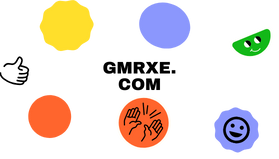 Gmrxe Entertainment and Information
Gmrxe Entertainment and Information
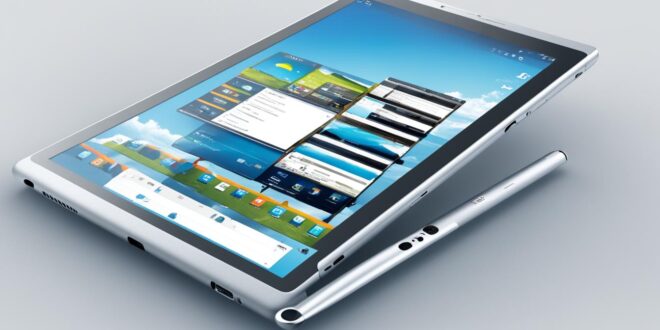
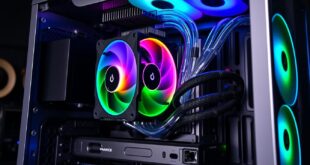

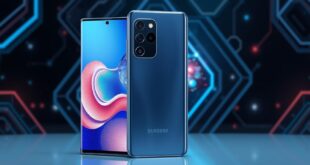

i use lenovo p series and its very good. its very good sound and cpu it has a strong battery